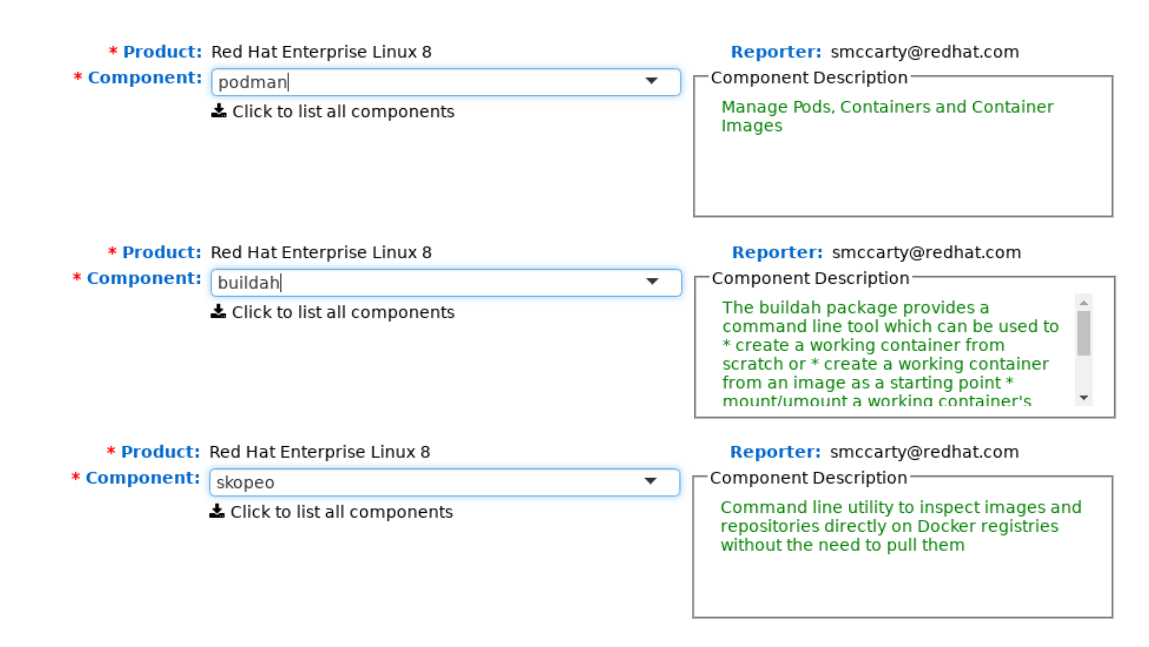So, you’ve been using Linux containers, and you want to check out what new features are available in Red Hat Enterprise Linux 8 Beta? We’ll provide a quick runthrough of some of the tools you’ll have available to work with containers.
This post will assume you can get a RHEL 8 Beta system installed - but, if you need a little guidance, check out the installation guide.
If you’re a container veteran, you may have developed a habit of tailoring your systems by installing the “docker” package. On your brand new RHEL 8 Beta system, the first thing you’ll likely do is go to your old friend yum. You’ll try to install the docker package, but to no avail. If you are crafty, next, you’ll search and find this package:
podman-docker.noarch : "package to Emulate Docker CLI using podman."
What is this Podman we speak of? The docker package is replaced by the Container Tools module, which consists of Podman, Buildah, Skopeo and several other tidbits. There are a lot of new names packed into that sentence so, let’s break them down.
-
Module - basically, a group of software that is released together in a single life cycle. For more see: Introducing Application Streams (AppStreams) in RHEL 8. Also, see the upstream Fedora Modularity documentation.
-
Podman - Simpler, daemon-less tool that provides a command line experience. If you can use the docker cli, you already know how to use podman. For more see this introduction by Doug Tidwell.
-
Buildah - powerful build tool which is designed to provide control over how image layers are committed, and how data is accessed during builds. For more, check out these tutorials.
-
Skopeo - flexible utility which enables moving, signing, and verifying of container images between registry servers and container hosts. For a quick introduction, see this tutorial.
These tools are compatible with the OCI specifications which means they can find, run, build and share containers with other tools that target the OCI standards including Docker CE, Docker EE, Kata Containers, CRI-O, and other container engines, registries, and tools. You can build with Buildah, and run with CRI-O. You can copy images from an AWS container registry to a local Podman instance. The OCI standards offer greater flexibility and choice. So, how might one get these new tools in Red Hat Enterprise Linux 8 Beta? Run this command on your Red Hat Enterprise Linux 8 Beta system:
yum module install -y container-tools
When this command completes, you will have all three tools installed and ready to go. Experiment, have fun, and let us know what you think. Once you have your packages installed, checkout the RHEL 8 Beta documentation to get started with podman, buildah, and skopeo: Building, running, and managing containers.
As you find features you think would be useful, or even bugs, please let us know. To file a feature or bug during the life of Red Hat Enterprise Linux 8 Beta, file an issue on Red Hat's Bugzilla instance. This link will take you directly to where you need to go, but you will need to create an account first, if you don't already have one.
When filing an issue, please select component to help us route these to the right teams. Here are a couple of screenshots to help:

We are proud to share the new Container Tools module in Red Hat Enterprise Linux 8 Beta. The goal is to enable users to find, run, build and share containers with greater ease and in new ways. It’s a community effort and we would love your feedback.
저자 소개
At Red Hat, Scott McCarty is Senior Principal Product Manager for RHEL Server, arguably the largest open source software business in the world. Focus areas include cloud, containers, workload expansion, and automation. Working closely with customers, partners, engineering teams, sales, marketing, other product teams, and even in the community, he combines personal experience with customer and partner feedback to enhance and tailor strategic capabilities in Red Hat Enterprise Linux.
McCarty is a social media start-up veteran, an e-commerce old timer, and a weathered government research technologist, with experience across a variety of companies and organizations, from seven person startups to 20,000 employee technology companies. This has culminated in a unique perspective on open source software development, delivery, and maintenance.
채널별 검색
오토메이션
기술, 팀, 환경을 포괄하는 자동화 플랫폼에 대한 최신 정보
인공지능
고객이 어디서나 AI 워크로드를 실행할 수 있도록 지원하는 플랫폼 업데이트
클라우드 서비스
관리형 클라우드 서비스 포트폴리오에 대해 더 보기
보안
환경과 기술 전반에 걸쳐 리스크를 감소하는 방법에 대한 최신 정보
엣지 컴퓨팅
엣지에서의 운영을 단순화하는 플랫폼 업데이트
인프라
세계적으로 인정받은 기업용 Linux 플랫폼에 대한 최신 정보
애플리케이션
복잡한 애플리케이션에 대한 솔루션 더 보기
오리지널 쇼
엔터프라이즈 기술 분야의 제작자와 리더가 전하는 흥미로운 스토리
제품
- Red Hat Enterprise Linux
- Red Hat OpenShift Enterprise
- Red Hat Ansible Automation Platform
- 클라우드 서비스
- 모든 제품 보기
툴
체험, 구매 & 영업
커뮤니케이션
Red Hat 소개
Red Hat은 Linux, 클라우드, 컨테이너, 쿠버네티스 등을 포함한 글로벌 엔터프라이즈 오픈소스 솔루션 공급업체입니다. Red Hat은 코어 데이터센터에서 네트워크 엣지에 이르기까지 다양한 플랫폼과 환경에서 기업의 업무 편의성을 높여 주는 강화된 기능의 솔루션을 제공합니다.

